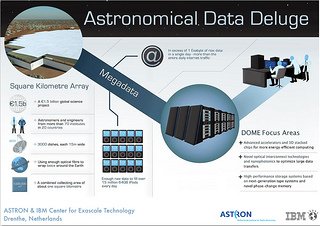A 30m euro research programme into fast, low power exascale computing capable of handling the data generated by the world’s largest radio telescope has been announced by IBM and Astron, the Dutch astonomy institute.
An initial 32.9m euro, five-year collaboration has been targeted for the international Square Kilometre Array (SKA).
The next generation of large scientific instruments, of which the SKA is a key example, requires a high-performance computing architecture and data transfer links with a capacity that far exceeds current state-of-the-art technology.
Astron and IBM scientists in the Netherlands and Switzerland have launched an initial five-year collaboration called Dome to investigate emerging technologies for large-scale and efficient exascale computing, data transport and storage processes, and streaming analytics that will be required to read, store and analyze all the raw data that will be collected daily.
The SKA is an international consortium to build the world’s largest and most sensitive radio telescope. Scientists estimate that the processing power required to operate the telescope will be equal to several millions of today’s fastest computers. It is due for completion in 2024 and will explore dark matter and origins of the universe.
Scientists from both organizations will collaborate at the newly established ASTRON & IBM Center for Exascale Technology in Drenthe, the Netherlands.
Ton Engbersen, IBM Research – Zurich explains, “If you take the current global daily Internet traffic and multiply it by two, you are in the range of the data set that the Square Kilometre Array radio telescope will be collecting every day. This is Big Data Analytics to the extreme. With Dome we will embark on one of the most data intensive science projects ever planned, which will eventually have much broader applications beyond radio astronomy research.”
Only by basing the overall design on architectures that are beyond the current state-of-the-art will it be possible to handle the vast amounts of data produced by the millions of antenna systems of the SKA.
“Large research infrastructures like the SKA require extremely powerful computer systems to process all the data. The only acceptable way to build and operate these systems is to dramatically reduce their power consumption. Dome gives us unique opportunities to try out new approaches in Green Supercomputing. This will be beneficial for society at large as well,” said Marco de Vos, Managing Director of Astron.

